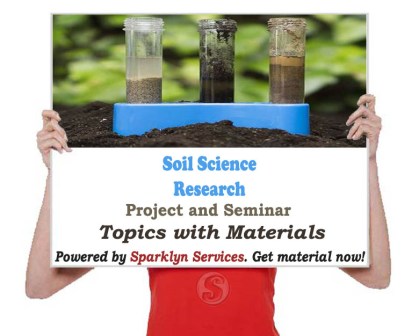1.1 Introduction
Cadmium (Cd), chromium (Cr) and lead (Pb) are the heavy metals of most concern because they can affect human health even in small quantities. Wa˚ngstrand et al. (2007) reported that application of nitrogen fertilizers containing ammonium-N may increase Cd concentrations in plants, even if the fertilizers do not contain significant levels of heavy metals. In addition, Atafar et al. (2010) were also observed that application of some non-heavy metal fertilizers can potentially increase concentrations of Cd, Cr, and Pb in plants.
As a prelude to other parts of this study, this chapter will discuss the background upon which this study was initiated, the statement of problems that led to this study, the Aim and Objectives of the study. Others are Significance of the study, Scope of work, Limitations of the Study and Definition of technical terms.
1.2 Background of Study
Several researchers have indicated that need for a better understanding of urban soil pollution (De Kimple and Morel, 2000; Manta et al., 2002), vegetation present on verges of roads (Okonkwo and Maribe, 2004; Chimuka et al., 2005; Awofolu, 2005). Roadside vegetation represents not only a distinct type of synanthropic vegetation, but in areas with high population density and an intense industrial or agricultural land- scape, roadside verges are often the only habitats where natural vegetation can develop (Ansari et al., 2003).
Accordingly, determining the available forms of heavy metals in soils is an important approach to the soil contamination assessment, especially in greenhouse areas which have great impact on environment and human health due to intensive use of fertilizers and pesticides containing heavy metals. The intensification of agricultural soil use, and changes in farming practice, characterized by intensive application of fertilizers and pesticides may cause soil pollution by heavy metals in greenhouses (Nouri et al., 2008). Namely, many chemical products used in agriculture, especially nitrogen and phosphate fertilizers; contain certain amounts of heavy metals, as result of their production from minerals used as a source of these elements.
Although the low level of heavy metals in fertilizers and pesticides in one-time use do not pose any hazard of soil or plant contamination, their long-term use in food crops production, especially in greenhouse vegetable production, contributed to the accumulation of heavy metals in the soils and consequently in food crops (Huang and Jin, 2008). However, up to now, heavy metal concentrations of greenhouse soil in Bosnia and Herzegovina and its pollution problem have been studied very little, especially there is no systematical investigation of the dynamics of heavy metals in the greenhouse soil-plant system in intensive tomato production. Since the heavy metals have a long residence time in soils, it is very important to study the status of heavy metals in soil, and their influence on vegetable safety, and consequently human health.
Therefore, in Rumuolumeni Port Harcourt where the research was carried out, the activities that was conducted is to determine the level of trace metals in plants and associated soil.
1.3 Statement of Problems
Investigation revealed that the human need of plants, damage as a result of post-bacteria spoilage micro-organisms has been of serious concern. Microbial decay is one of the main factors that determine losses and compromises the quality of the produce. The extent of the losses especially through microbial decay has not been quantified in most areas and on this has been quantified the result are short lived.
1.4 Aim and Objectives of Study
The aim of the study is to determine the level of trace metals in plants and associated soil in Rumuolumeni Port Harcourt. In achieving this aim, the following specific objectives were laid out as follows:
- To assess the level of contamination of surface roadside soil and plants by some heavy metals along major and minor
- To examine the concentration of total and available forms of heavy metals (Ni, Cr, Cu, Zn, Pb and Mn) in the soil
- To investigate the physico-chemical parameters and heavy metals concentration in soil and some commonly cultivated crops from farmlands in Rumuolumeni Port Harcourt
1.5 Research Questions
The study came up with research questions so as to be able to ascertain the above stated objectives. The specific research questions for the study are stated below as follows:
- What is the physico-chemical parameters and heavy metals concentration in soil and some commonly cultivated crops from farmlands?
- What is the concentration of total and available forms of heavy metals (Ni, Cr, Cu, Zn, Pb and Mn) in the soil of Rumuolumeni Port Harcourt?
- What is the level of contamination of surface roadside soil and plants by some heavy metals along major and minor in Rumuolumeni Port Harcourt?
1.6 Significance of Study
This study will be of immense benefit to researchers who intend to know more on this study and can also be used by non-researchers to build more on their research work. This study contributes to knowledge and could serve as a guide for other study.
1.7 Scope of Study
The scope of the research is focused on the Determination of the Level of Trace Metals in Plants and Associated Soil in Rumuolumeni Port Harcourt. This study is limited to tomatoes plant.
1.8 Limitations of the Study
During the course of this study, many things militated against its completion, some of which are:
- Time Constraint: The time frame given to accomplish this project was very short due to school academic calendar and it was carried out under pressure which made the researcher not to implement some necessary features.
- Research material: availability of research material is a major setback to the scope of the study.
- Frequent power failure: This made the researcher append more money on fuel to ensure sustainable power.
- Financial Constraint: Insufficient fund tends to impede the efficiency of the researcher in sourcing for the relevant materials, literature or information and in the process of data collection (internet).




